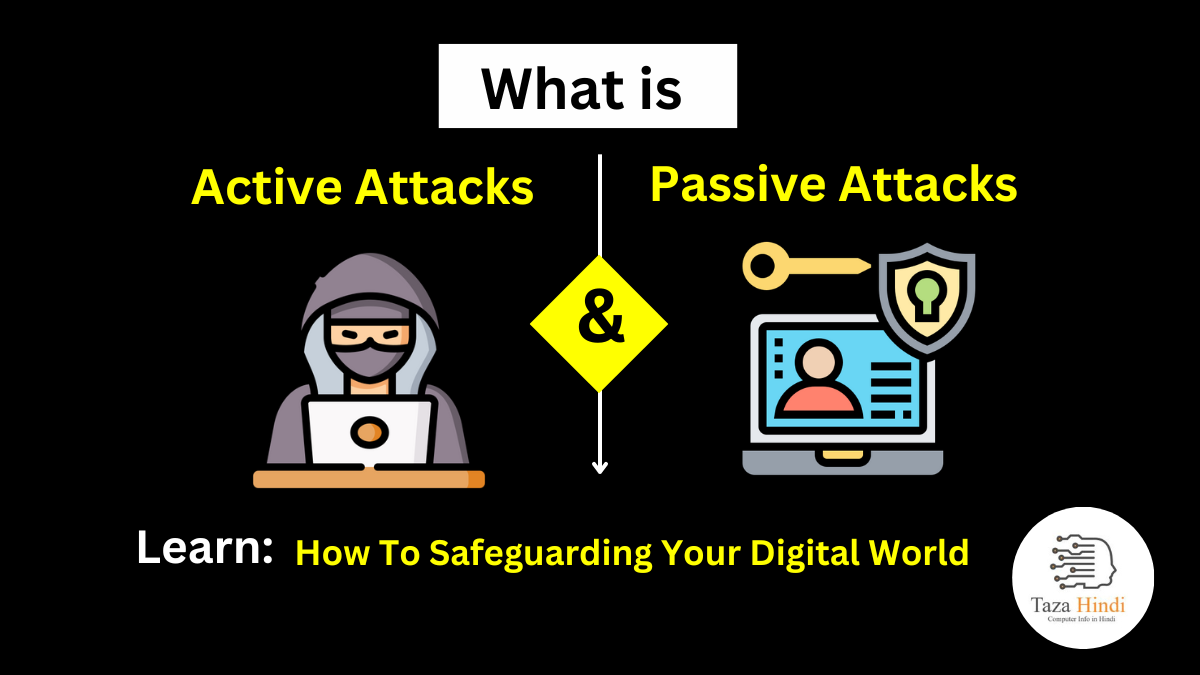In today’s interconnected world, cyber security attacks pose a significant threat to individuals and organizations alike. Understanding the difference between active and passive attacks is crucial for developing effective defense strategies. This is a comprehensive article delves into the various types of cyber security attacks, explores what are the difference between active and passive attacks, examines real-world examples and their consequences, and provides invaluable tips for protecting against both types of attacks.
What are cyber security attacks?
Cyber security attacks encompass a wide range of malicious activities aimed at compromising the confidentiality, integrity, or availability of digital systems and data. Attackers exploit vulnerabilities in networks, software, and human behavior to gain unauthorized access or disrupt operations.
Types of Cyber Security Attacks
Before diving into the specifics of active and passive attacks, it’s important to understand the broader categories of cyber security attacks. These include malware, phishing, social engineering, denial-of-service (DoS) attacks, and man-in-the-middle (MitM) attacks.
What is an Active Attack?
Active attacks involve direct interaction between the attacker and the target system, often with the intention of gaining unauthorized access, stealing sensitive information, or causing disruptions. Active attacks are characterized by the attacker’s direct involvement and manipulation of the target system.
Also Read : What is Debugging? Understanding the Essential Process in Software Development
Types of Active Attacks
Active attacks come in various forms, including malware and ransomware, phishing and social engineering, DoS and DDoS attacks, and MitM attacks. Each type exploits different vulnerabilities and employs different techniques to achieve its objectives.
How active attacks work?
Active attacks exploit vulnerabilities in systems and networks to compromise their security. Malware and ransomware infiltrate systems to gain control or encrypt data, phishing and social engineering trick individuals into revealing sensitive information, DoS and DDoS attacks overwhelm networks to disrupt services, and MitM attacks intercept and manipulate communications.
Real-world examples of active attacks and their consequences
Examining real-world examples sheds light on the severity and impact of active attacks. Notable instances include the WannaCry ransomware attack, the CEO fraud phishing scam, the Mirai botnet-driven DDoS attack, and the Wi-Fi Pineapple MitM attack. These cases highlight the devastating consequences active attacks can have on individuals and organizations.
Also Read : Difference between Greedy and Dynamic Programming
How to protecting against active attacks?
Prevention is key when it comes to active attacks. Implementing robust security measures such as firewalls, antivirus software, multi-factor authentication, and user awareness training can significantly reduce the risk of falling victim to active attacks. Regular software updates and backups also play a critical role in mitigating their impact.
What is Passive Attack?
Passive attacks are characterized by the attacker’s eavesdropping or monitoring activities, without directly interacting with the target system. The objective of passive attacks is to gather information or exploit data leaks without alerting the victim.
Types of Passive Attacks
Passive attacks encompass techniques like packet sniffing and eavesdropping, data interception and monitoring, and network reconnaissance and information gathering. These attacks focus on silently capturing and analyzing data without raising suspicions.
How Passive attacks work?
Passive attacks exploit vulnerabilities in data transmission and storage to intercept and monitor sensitive information. Packet sniffing captures network traffic, data interception targets communication channels, and network reconnaissance aims to gather valuable intelligence.
Also Read : Difference between Static and Dynamic Memory Allocation
Real-world examples of Passive attacks and their consequences
Passive attacks have had significant consequences in various scenarios. The Target data breach, the Equifax data breach, and the Snowden revelations are notable examples. These incidents underscore the importance of protecting against passive attacks and the potential harm they can cause.
How to protecting against Passive attacks?
Protecting against passive attacks requires a multi-faceted approach. Encryption of data in transit and at rest, implementing secure communication protocols, using virtual private networks (VPNs), and employing strong access controls and monitoring mechanisms are all essential measures to mitigate the risk of passive attacks.
Differences between Active and Passive attacks
| Active attacks | Passive attacks |
| Active attacks involve direct interaction between the attacker and the target system. The attacker actively manipulates the system to gain unauthorized access, steal data, or cause disruptions. | Passive attacks do not involve direct interaction with the target system. The attacker focuses on eavesdropping or monitoring activities to gather information without alerting the victim.
|
| Active attacks are typically aimed at gaining control, extracting sensitive information, or causing disruptions to the target system or network. The attacker actively seeks to exploit vulnerabilities for their own benefit. | Passive attacks focus on information gathering and data interception. The attacker aims to capture valuable data or gain insights without altering the target system’s functionality. |
| Active attacks are generally more easily detected than passive attacks. Active attacks involve direct manipulation of the target system, which can leave traces in system logs or generate abnormal network traffic patterns. | Passive attacks, however, are often more challenging to detect since they involve eavesdropping or monitoring without altering the system’s behavior. The victim may remain unaware that their data is being intercepted or monitored. |
| Active attacks can have immediate and noticeable impacts on the target system or network. They can lead to system crashes, data breaches, financial losses, or service disruptions. | Passive attacks, although they may not cause immediate disruptions, can have long-term consequences. The intercepted data can be used for identity theft, espionage, or other malicious activities, leading to serious repercussions for the victim. |
| Protecting against active attacks involves implementing security measures such as firewalls, intrusion detection systems, encryption, and user awareness training to detect and prevent unauthorized access and malicious activities. | Defending against passive attacks requires measures like data encryption, secure communication protocols, access controls, and network monitoring to detect and prevent unauthorized data interception or monitoring. |
Also Read : What is Computer Security and how to protect from attacks
Conclusion
Safeguarding your digital world necessitates a comprehensive understanding of active and passive attacks. By recognizing the nuances of each attack type, their working principles, and the preventive measures available, individuals and organizations can better protect themselves against the evolving landscape of cyber security threats.
FAQs
-
What is the main difference between active and passive attacks?
The main difference between active and passive attacks lies in their approach and level of interaction. Active attacks involve direct manipulation of the target system by the attacker, while passive attacks focus on eavesdropping or monitoring without direct interaction.
-
How can I protect my system from active attacks?
To protect your system from active attacks, it is essential to implement robust security measures such as firewalls, antivirus software, multi-factor authentication, and user awareness training. Regular software updates and backups are also crucial. Maintaining a proactive stance and staying updated on the latest security threats is vital.
-
Are there any warning signs of passive attacks?
Warning signs of passive attacks may include unusual network activity, unexpected data leaks, unauthorized access attempts, or suspicious behavior observed in system logs. Implementing intrusion detection systems and performing regular security audits can help identify and mitigate passive attacks.
-
Can active and passive attacks occur simultaneously?
Yes, active and passive attacks can occur simultaneously. Attackers may employ a combination of tactics to achieve their objectives. It is important to have a comprehensive defense strategy that addresses both types of attacks.
-
What are the long-term consequences of falling victim to active or passive attacks?
Falling victim to active or passive attacks can have severe long-term consequences. These may include financial losses, compromised personal or sensitive data, reputational damage, disruption of services, and legal ramifications. Prompt response, incident handling, and recovery measures are crucial to minimize the impact of such attacks.



